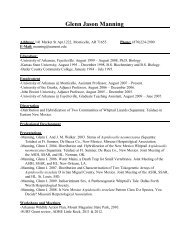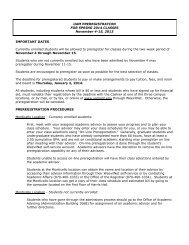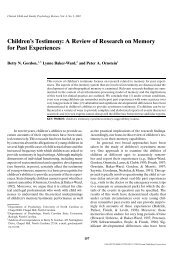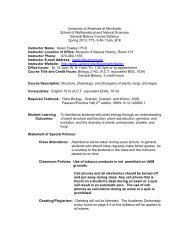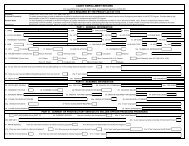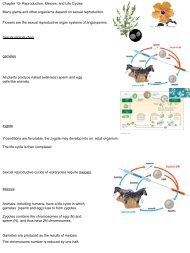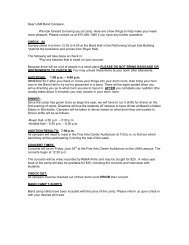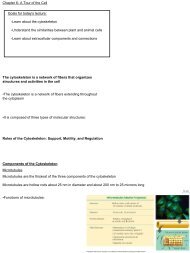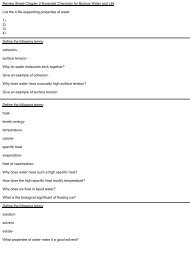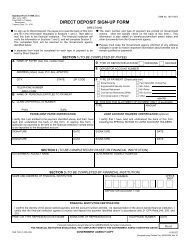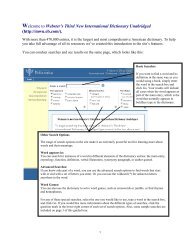A TAAP - University of Arkansas at Monticello
A TAAP - University of Arkansas at Monticello
A TAAP - University of Arkansas at Monticello
Create successful ePaper yourself
Turn your PDF publications into a flip-book with our unique Google optimized e-Paper software.
Solution and Scoring<br />
Part Points<br />
1 1 point possible<br />
PART II Geometry Released Items––April 2007<br />
1 point: Correct name, st<strong>at</strong>ement <strong>of</strong>, or explan<strong>at</strong>ion <strong>of</strong> theorem.<br />
Give credit for the following or equivalent:<br />
• The Triangle Inequality Theorem, or<br />
• “The sum <strong>of</strong> the lengths <strong>of</strong> any two sides <strong>of</strong> a triangle is gre<strong>at</strong>er than the length <strong>of</strong> the<br />
third side” (give credit if “any” is omitted), or<br />
• “Take the two shortest lengths and add them together. Th<strong>at</strong> number must be bigger than<br />
the third length,” or<br />
• “The length <strong>of</strong> a side <strong>of</strong> a triangle must be between the sum and difference <strong>of</strong> the other<br />
two lengths.”<br />
Note: No credit for the Pythagorean Theorem or its st<strong>at</strong>ement.<br />
2 3 points possible<br />
Note: No credit will be awarded in Part 2 for answer or procedure if support is completely invalid<br />
(obviously incorrect procedure) in Parts 1 and/or 2 with no correct procedure shown.<br />
Ex: “Jason could use 3-, 4-, and 5-inch rods because they’re closest together.” (True, but insufficient.)<br />
Ex: “P<strong>at</strong>rick could use 4-, 15-, and 16-inch rods because you could make a right triangle.” (Not true.)<br />
½ point: Correct combin<strong>at</strong>ion for Jason: 3-, 4-, and 5-inch rods.<br />
AND<br />
½ point: Correct and complete procedure shown.<br />
Work may contain a calcul<strong>at</strong>ion or copy error if answer is incorrect.<br />
Give credit for the following or equivalent:<br />
• 5 + 3 > 4, 5 + 4 > 3, 3 + 4 > 5, or<br />
• 3 + 4 > 5, or<br />
• 5 + 4 = 9 > 3 and 5 − 4 = 1 < 3. (If using this method, it is not necessary to check all<br />
three pairs.)<br />
Note: If student uses the Pythagorean Theorem in Part 1 ,<br />
then credit will be<br />
awarded for 3, 4, 5 with or without correct procedure shown.<br />
AND<br />
½ point: 1 correct combin<strong>at</strong>ion for P<strong>at</strong>rick: 4-, 15-, and 16-inch rods or 9-, 15-, and 16-inch rods.<br />
AND<br />
½ point: Correct and complete procedure shown for appropri<strong>at</strong>e combin<strong>at</strong>ion.<br />
Work may contain a calcul<strong>at</strong>ion or copy error if answer is incorrect.<br />
Give credit for the following or equivalent:<br />
• 4 + 15 > 16, 4 + 16 > 15, 15 + 16 > 4, or<br />
• 9 +15 > 16, 9 + 16 > 15, 15 + 16 > 9, or<br />
• 4 + 15 > 16 or 9 + 15 > 16, or<br />
• 4 + 16 = 20 > 15 and 16 − 4 = 12 < 15, or<br />
• 16 + 15 = 31 > 9 and 16 − 15 = 1 < 9.<br />
AND<br />
½ point: Correct response for Bryce: No combin<strong>at</strong>ion works.<br />
AND<br />
½ point: Give credit for the following or equivalent:<br />
• All 4 combin<strong>at</strong>ions are checked:<br />
7, 2, 10 : 7 + 2 < 10<br />
7, 2, 19 : 7 + 2 < 19<br />
2, 10, 19 : 2 + 10 < 19<br />
7, 10, 19 : 7 + 10 < 19, or<br />
• The smallest three numbers and the largest three numbers are checked as follows:<br />
7, 2, 10: 7 + 2 < 10 (Work for 7, 2 ,19 is not required.)<br />
7, 10, 19: 7 + 10 < 19 (Work for 2, 10, 19 is not required.)<br />
31



